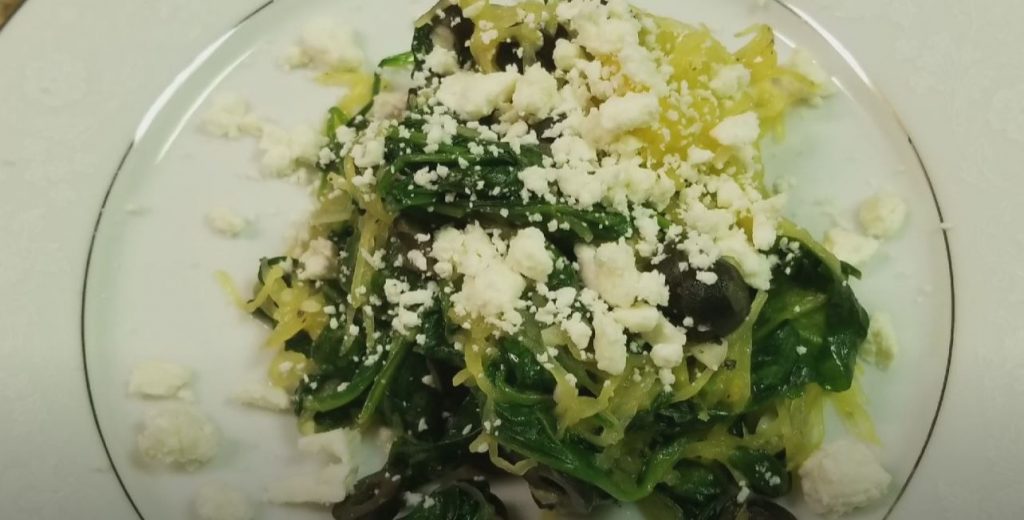This Greek spaghetti squash recipe is a light and flavorful dish that is sure to impress. The strands of spaghetti squash are tossed in a tangy lemon and oregano sauce, topped with crumbled feta cheese and juicy tomatoes. It's a healthy and delicious meal that perfectly encapsulates the fresh, vibrant flavors of Greek cuisine.

Photos of Greek Spaghetti Squash Recipe
An uncommon ingredient that you might not have on hand is spaghetti squash. It's a winter squash that's available in most supermarkets, and when cooked, its flesh can be pulled into spaghetti-like strands. These strands are low in calories and carbs but high in fiber, making it a great substitute for pasta. Another ingredient to note is feta cheese, a briny, tangy cheese popular in Greek cuisine. If you can't find it, try using a similarly crumbly cheese like ricotta salata.
Ingredients for Greek Spaghetti Squash
Spaghetti squash: A variety of squash that turns into stringy strands when cooked, resembling spaghetti. It's a low-calorie, low-carb alternative to pasta.
Butter: Adds a rich, creamy flavor to the dish.
Tomato: Adds a sweet and slightly tangy flavor, and a vibrant splash of red color.
Feta cheese: A salty, crumbly cheese that adds a burst of flavor. If unavailable, you can replace it with another crumbly cheese like ricotta salata.
Fresh oregano: Gives a pungent and slightly bitter flavor that's essential in Greek cooking.
Lemon: Adds a bright, tangy note to the dish.
Water: Used to cook the squash.
Salt and fresh black pepper: Enhances the overall flavor of the dish.
One reader, Juan Aponte says:





This Greek spaghetti squash recipe is a game-changer! The combination of fresh oregano, tangy feta, and zesty lemon creates a burst of Mediterranean flavors. It's a healthy and satisfying alternative to traditional pasta dishes. I highly recommend trying it out for a delightful and guilt-free meal.
Essential Techniques for Crafting Greek Spaghetti Squash
How to cook spaghetti squash: Spaghetti squash can be cooked in the microwave or baked in the oven. The squash is cut in half, seeds removed, and then cooked until the flesh is tender and can be easily scraped into strands.
How to prepare fresh oregano: Fresh oregano should be rinsed and patted dry. The leaves can then be removed from the stems and chopped finely before using in the recipe.
How to serve: The Greek spaghetti squash can be served warm as a side dish or as a main course. It can be garnished with additional feta cheese and a sprinkle of fresh oregano for added flavor.
How To Make Greek Spaghetti Squash
Turn your spaghetti squash into something yummy with our easy recipe made with butter, tomato, feta cheese, fresh oregano, and lemon!
Serves:
Ingredients
- 1spaghetti squash
- 1tbspbutter
- 1tomato,finely diced, drained
- ¾cupfeta cheese,crumbled
- 1tbspfresh oregano,chopped
- ½lemon,juiced
- ⅓cupwater
- salt and fresh black pepper,to taste
Instructions
-
Cut the spaghetti squash in half lengthwise and scoop out the seeds. Place ⅓ cup of water in a small casserole dish and add squash face down.
-
Cover with plastic wrap and microwave for 8 minutes. Alternatively, place the spaghetti squash with cut sides down on a greased baking sheet and bake for 30 to 35 minutes at 375 degrees F (the skin should be easily pierced with a fork once done).
-
Once cooked, use a fork to scrape out the squash and separate the strands. Toss with the remaining ingredients.
-
Serve warm.
Nutrition
- Calories: 94.72kcal
- Fat: 6.38g
- Saturated Fat: 4.12g
- Trans Fat: 0.08g
- Monounsaturated Fat: 1.41g
- Polyunsaturated Fat: 0.38g
- Carbohydrates: 7.26g
- Fiber: 1.70g
- Sugar: 3.31g
- Protein: 3.43g
- Cholesterol: 21.78mg
- Sodium: 297.27mg
- Calcium: 121.94mg
- Potassium: 151.57mg
- Iron: 0.64mg
- Vitamin A: 52.85µg
- Vitamin C: 6.80mg
Expert Technique Advice for Perfect Greek Spaghetti Squash
When scraping out the spaghetti squash, ensure to use a fork and not a spoon. This will help you get longer, spaghetti-like strands. Also, be gentle while scraping to avoid mashing the squash. This will help maintain the texture and appearance of the dish.
Time-Saving Tips for Greek Spaghetti Squash Recipe
Prep ahead: Roast the spaghetti squash in advance and store it in the refrigerator for up to 3 days. This will save time when you're ready to prepare the dish.
Efficient cooking: Use a microwave to cook the spaghetti squash quickly, or bake it in the oven while multitasking with other meal prep.
Easy cleanup: Line the baking sheet with parchment paper or aluminum foil for easy cleanup after roasting the spaghetti squash.
Versatile ingredients: Use pre-crumbled feta cheese and pre-chopped oregano to cut down on prep time.
Batch cooking: Cook multiple spaghetti squashes at once and store the extra strands in the fridge or freezer for future use.
Substitute Ingredients For Greek Spaghetti Squash Recipe
spaghetti squash - Substitute with zucchini noodles: Zucchini noodles can be used as a low-carb alternative to spaghetti squash, providing a similar texture and mild flavor.
butter - Substitute with olive oil: Olive oil can be used as a healthier alternative to butter, adding a rich flavor to the dish.
tomato - Substitute with sun-dried tomatoes: Sun-dried tomatoes can be used to add a more intense and concentrated flavor compared to fresh tomatoes.
feta cheese - Substitute with goat cheese: Goat cheese can be used as a tangy and creamy alternative to feta, adding a unique flavor to the dish.
fresh oregano - Substitute with dried oregano: Dried oregano can be used as a substitute for fresh oregano, providing a similar flavor profile with a more concentrated taste.
lemon - Substitute with white wine vinegar: White wine vinegar can be used to add a tangy and acidic flavor similar to lemon juice.
water - Substitute with vegetable broth: Vegetable broth can be used to add more depth of flavor to the dish compared to water.
How to Beautifully Present Greek Spaghetti Squash
Elevate the plating: When presenting this Greek spaghetti squash recipe, focus on creating an elegant and visually appealing presentation. Consider using white plates to showcase the vibrant colors of the dish and arrange the strands of spaghetti squash in a neat and organized manner.
Incorporate fresh herbs: Garnish the dish with a sprinkle of freshly chopped oregano to add a pop of color and a burst of fresh flavor. This will not only enhance the visual appeal but also elevate the overall taste of the dish.
Artful drizzle of lemon: Incorporate a subtle and artful drizzle of freshly squeezed lemon juice around the edges of the plate to add a touch of brightness and acidity to the dish.
Use feta as a finishing touch: Crumble the feta cheese over the top of the spaghetti squash, allowing it to cascade gracefully down the sides, creating a visually stunning and appetizing presentation.
Butter for a glossy finish: Before serving, add a small pat of butter to the center of the dish. This will create a glossy finish on the spaghetti squash, adding a touch of richness and enhancing the overall presentation.
Essential Kitchen Tools for Making Greek Spaghetti Squash
- Cutting board: A flat surface used for cutting, slicing, and chopping ingredients.
- Chef's knife: A versatile kitchen knife used for a variety of food preparation tasks such as chopping, slicing, and dicing.
- Microwave: An appliance used for quickly cooking or reheating food.
- Fork: A utensil with prongs used for picking up and eating food.
- Baking sheet: A flat, rectangular metal pan used for baking and roasting foods in the oven.
- Plastic wrap: A thin plastic film used to cover and protect food.
- Mixing bowl: A bowl used for mixing ingredients together.
- Fork: A utensil with prongs used for picking up and eating food.
Proper Storage and Freezing Guidelines for Greek Spaghetti Squash
- Let the spaghetti squash cool completely before storing it in an airtight container in the refrigerator. It will keep fresh for up to 4 days.
- To freeze the greek spaghetti squash, place the cooled dish in a freezer-safe container or resealable plastic bag. Squeeze out any excess air to prevent freezer burn.
- Label the container with the date and contents for easy identification later on.
- When you're ready to enjoy your frozen spaghetti squash, simply thaw it overnight in the refrigerator.
- Reheat the thawed spaghetti squash in the microwave or in a skillet over medium heat until warmed through. Add a splash of water or olive oil if needed to help revive the texture.
- Note: The spaghetti squash may release some excess liquid upon thawing, so drain it well before reheating. The tomatoes and feta cheese may also change in texture slightly after being frozen, but the dish will still be delicious!
The Best Methods for Reheating Leftover Greek Spaghetti Squash
- To reheat leftover greek spaghetti squash, start by placing the desired amount in a microwave-safe dish. Cover the dish with a damp paper towel to help retain moisture and prevent the squash from drying out during the reheating process.
- Microwave the spaghetti squash on high power for 1-2 minutes, or until it reaches your desired temperature. The exact time may vary depending on the amount of squash and the power of your microwave. Be sure to stir the squash halfway through the reheating process to ensure even heating.
- Alternatively, you can reheat the greek spaghetti squash in a skillet on the stovetop. Add a small amount of butter or olive oil to the skillet and heat over medium heat. Add the leftover squash to the skillet and stir occasionally until it is heated through, about 3-5 minutes.
- If you prefer a crispy texture, you can also reheat the spaghetti squash under the broiler. Preheat your oven's broiler and place the leftover squash on a baking sheet. Broil for 1-2 minutes, or until the top is lightly browned and crispy. Keep a close eye on the squash to prevent burning.
- Regardless of the reheating method you choose, be sure to taste the greek spaghetti squash and adjust the seasoning as needed. You may want to add a squeeze of fresh lemon juice, a sprinkle of feta cheese, or a pinch of salt and black pepper to refresh the flavors.
- Once the spaghetti squash is heated through and seasoned to your liking, serve it immediately while it's still hot. Enjoy your delicious and healthy leftover meal!
Fascinating Trivia About Greek Spaghetti Squash
Spaghetti squash is a great source of nutrients, including vitamin C, vitamin A, and fiber. It's also low in calories, making it a healthy alternative to traditional pasta. The combination of feta cheese and fresh oregano in this recipe adds a delicious Greek flavor to the dish.
Budget-Friendly Greek Spaghetti Squash for Home Cooks
This Greek spaghetti squash recipe is quite cost-effective for a household. The main ingredient, spaghetti squash, is affordable and nutritious. The addition of feta cheese and tomatoes enhances the flavor without significantly increasing the cost. The use of fresh oregano and lemon adds a burst of freshness without breaking the bank. Overall, this recipe offers a great balance of cost and flavor. On a scale of 1-10, I would rate it an 8 for cost-effectiveness. The approximate cost for a household of 4 people would be around $10-$12, making it a budget-friendly option.
Is This Greek Spaghetti Squash Dish Healthy?
This Greek spaghetti squash recipe is a healthier alternative to traditional pasta dishes. Spaghetti squash is a low-calorie, nutrient-dense vegetable that provides a good source of fiber, vitamins, and minerals. The addition of tomato and oregano adds a burst of flavor and antioxidants, while the feta cheese provides a tangy, salty taste and a boost of protein and calcium. The lemon juice adds a bright, citrusy note and helps to balance the flavors.
However, the recipe could be further improved to make it even healthier:
- Use a healthier fat source, such as olive oil, instead of butter to sauté the ingredients
- Increase the amount of vegetables by adding more tomatoes, bell peppers, or spinach to boost the fiber and nutrient content
- Reduce the amount of feta cheese or opt for a lower-fat variety to decrease the saturated fat content
- Add a lean protein source, such as grilled chicken or shrimp, to make the dish more satisfying and balanced
- Experiment with different herbs and spices, like garlic, basil, or red pepper flakes, to enhance the flavor without adding extra calories
Our Editor's Honest Opinion on Greek Spaghetti Squash
This Greek spaghetti squash recipe is a delightful twist on traditional pasta dishes. The combination of feta cheese, fresh oregano, and lemon adds a burst of Mediterranean flavors to the dish. The use of spaghetti squash as a low-carb alternative to pasta makes this recipe both healthy and satisfying. The cooking method ensures that the squash strands are perfectly tender and flavorful. Overall, this recipe offers a refreshing and delicious way to enjoy a taste of Greece in a light and wholesome dish.
Enhance Your Greek Spaghetti Squash Recipe with These Unique Side Dishes:
Delicious Alternatives to Greek Spaghetti Squash Recipe
Perfect Appetizer and Dessert Pairings for Greek Spaghetti Squash
Why trust this Greek Spaghetti Squash Recipe:
This recipe offers a delightful twist on traditional spaghetti squash, infusing it with the rich flavors of Greek cuisine. The combination of fresh tomatoes, tangy feta cheese, and aromatic oregano creates a harmonious blend of Mediterranean flavors. The use of butter adds a touch of richness, while the hint of lemon brightens the dish. With its simple yet flavorful ingredients, this recipe promises to deliver a satisfying and wholesome Greek-inspired meal that's both delicious and nutritious.
Was this page helpful?
Have your own special recipe to share? Submit Your Recipe Today!










